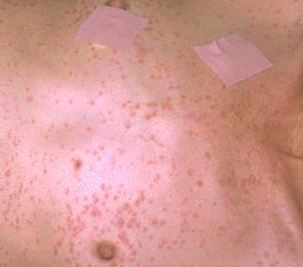A 23 y.o. female involved in a head on MVC, is awake and alert. She is taken to the OR and post op does not wake up.
A chest Ct looking for PE is neg for PE but shows the findings below.
patchy ground glass infiltrates are seen HInt: she had a leg fracture
What could be wrong?
our patient had fat emboli from a femur fracture
Our patient had a fat emboli syndrome. Fat emboli occur in nearly all patients that have fractures of the long bones but in a small percentage this results in fat emboli syndrome (FES). This occurs in 3-10% of ortho trauma patients and the mortality is 10-20%. Manifectations occure 24-72 hours after injury Embolized fat is degraded into free fatty acids, which cause toxic injury and inflammation causing edema.
mini infarct in the brain on her T2 weighted images.
The classic triad involves lung, brain and skin. It was first described by Zenker in 1862. The pulmonary manifestations are the most common with hypoxia as the main presentation. The neuroabnormalities include confusion, focal deficits and seizures. There is a petechial rash in 20 per cent of cases often on the head and neck. Lipiduria may also be present. Fat globules can be seen in bronchoalveolar lavage specimens.
fat globues with Oil red O stain in macrophages on bronchoalveolar lavage.
In the correct clinical setting, as in our patient the diagnosis can be made. Other forms of trauma have been associated with fat embolism syndrome including liposuction and CPR. There are also rare cases of nontrauma-related FES including sickle cell anemia, pancreatitis and lipid infusions.
Albumin has been recommended for treatment since it binds fatty acids. It is not clear if steroids are effective.
Our patient was unable to speak after surgery secondary to cerebral fat emboli and mini strokes. She has gradually improved and now is able to speak although she is very slow to respond to questions and will be discharged to rehab.
petechiae in fat embolism
Shaikh N, Emergency management of fat embolism syndrome. 2009 J Emerg Trauma Shock. Jan-April 2(1);19-33.
Fourme T, Viellard-Baron. Et al. Early fat embolism after liposuction. Anaesthesiology 1998 ;89:782-4.
Verdrinne J, Guillauma C, Gagnieu M. et al. Bronchoalveolar lavage in trauma patients for diagnosis of fat embolism syndrom. Chest 1992;102:1323-7.
Gangaraju R, Reddy V, Marques M. Fat embolism syndrome secondary to bone marrow necrosis in patients with hemoglobinopathies. South Med 2016;109-549.




